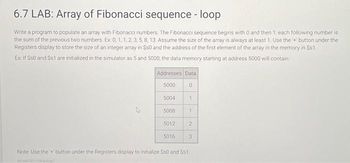
Database System Concepts
7th Edition
ISBN: 9780078022159
Author: Abraham Silberschatz Professor, Henry F. Korth, S. Sudarshan
Publisher: McGraw-Hill Education
expand_more
expand_more
format_list_bulleted
Question

Transcribed Image Text:Assembly
Line 1 Type your code here.
Line 2 # Do not initialize $s0 and $s1 here.
Line 3 # Use the + button under the Register displa
Line 4
ENTER SIMULATION
More options
Submit for grading
STEP
RUN
Registers
Each has value 0
Load de
Memory
Each has value 0

Transcribed Image Text:6.7 LAB: Array of Fibonacci sequence - loop
Write a program to populate an array with Fibonacci numbers. The Fibonacci sequence begins with 0 and then 1, each following number is
the sum of the previous two numbers. Ex: 0, 1, 1, 2, 3, 5, 8, 13. Assume the size of the array is always at least 1. Use the + button under the
Registers display to store the size of an integer array in $50 and the address of the first element of the array in the memory in Ss1.
Ex If Ss0 and Ss1 are initialized in the simulator as 5 and 5000, the data memory starting at address 5000 will contain:
Addresses Data
5000
0
5004
5008
5012
5016
1
1
2
3
Note Use the button under the Registers display to initialize $50 and Ss1.
Expert Solution
This question has been solved!
Explore an expertly crafted, step-by-step solution for a thorough understanding of key concepts.
This is a popular solution
Trending nowThis is a popular solution!
Step by stepSolved in 4 steps with 2 images

Knowledge Booster
Learn more about
Need a deep-dive on the concept behind this application? Look no further. Learn more about this topic, computer-science and related others by exploring similar questions and additional content below.Similar questions
- Program: Using a multidimensional array, create a triangular-shaped array. You will ask the user how many lines they want to see and then create the array, fill it, and then print it. You will fill the array with one 1 in the first row, two 2’s in the second row, etc. This should work for any integer that the user enters. (Just because I am starting on 1 does not mean row 0 was skipped.) You must: use a loop to create the array shape. You must: use nested for loops to fill the array and to print the values back to the screen. Your program should print as shown below. Example Output: How many lines would you like in your triangle? >>>9 1 2 2 3 3 3 4 4 4 4 5 5 5 5 5 6 6 6 6 6 6 7 7 7 7 7 7 7 8 8 8 8 8 8 8 8 9 9 9 9 9 9 9 9 9 If your code looks like the code below, it is not what I’m asking for. The code below is making a square multidimensional array, not a triangular one. The code below is just leaving certain spots empty so that it looks like a triangle. I will ask you…arrow_forwardWrite an application that prompts the user to enter nine integers and then store those nine integers in an array. Display the integers from first to last, and then display the integers from last to first. You do not have to sort them, just display the order entered and the reverse order entered. (In JAVA)arrow_forwardThe Lo Shu Magic Square is a grid with 3 rows and 3 columns shown below. The Lo Shu Magic Square has the following properties: The grid contains the numbers 1 – 9 exactly The sum of each row, each column and each diagonal all add up to the same number. This is shown below: Write a program that simulates a magic square using 3 one dimensional parallel arrays of integer type. Do not use two-dimensional array. Each one the arrays corresponds to a row of the magic square. The program asks the user to enter the values of the magic square row by row and informs the user if the grid is a magic square or not. Processing Requirements - c++ Use the following template to start your project: #include<iostream> using namespace std; // Global constants const int ROWS = 3; // The number of rows in the array const int COLS = 3; // The number of columns in the array const int MIN = 1; // The value of the smallest number const int MAX = 9; // The value of the largest number //…arrow_forward
Recommended textbooks for you
 Database System ConceptsComputer ScienceISBN:9780078022159Author:Abraham Silberschatz Professor, Henry F. Korth, S. SudarshanPublisher:McGraw-Hill Education
Database System ConceptsComputer ScienceISBN:9780078022159Author:Abraham Silberschatz Professor, Henry F. Korth, S. SudarshanPublisher:McGraw-Hill Education Starting Out with Python (4th Edition)Computer ScienceISBN:9780134444321Author:Tony GaddisPublisher:PEARSON
Starting Out with Python (4th Edition)Computer ScienceISBN:9780134444321Author:Tony GaddisPublisher:PEARSON Digital Fundamentals (11th Edition)Computer ScienceISBN:9780132737968Author:Thomas L. FloydPublisher:PEARSON
Digital Fundamentals (11th Edition)Computer ScienceISBN:9780132737968Author:Thomas L. FloydPublisher:PEARSON C How to Program (8th Edition)Computer ScienceISBN:9780133976892Author:Paul J. Deitel, Harvey DeitelPublisher:PEARSON
C How to Program (8th Edition)Computer ScienceISBN:9780133976892Author:Paul J. Deitel, Harvey DeitelPublisher:PEARSON Database Systems: Design, Implementation, & Manag...Computer ScienceISBN:9781337627900Author:Carlos Coronel, Steven MorrisPublisher:Cengage Learning
Database Systems: Design, Implementation, & Manag...Computer ScienceISBN:9781337627900Author:Carlos Coronel, Steven MorrisPublisher:Cengage Learning Programmable Logic ControllersComputer ScienceISBN:9780073373843Author:Frank D. PetruzellaPublisher:McGraw-Hill Education
Programmable Logic ControllersComputer ScienceISBN:9780073373843Author:Frank D. PetruzellaPublisher:McGraw-Hill Education

Database System Concepts
Computer Science
ISBN:9780078022159
Author:Abraham Silberschatz Professor, Henry F. Korth, S. Sudarshan
Publisher:McGraw-Hill Education

Starting Out with Python (4th Edition)
Computer Science
ISBN:9780134444321
Author:Tony Gaddis
Publisher:PEARSON

Digital Fundamentals (11th Edition)
Computer Science
ISBN:9780132737968
Author:Thomas L. Floyd
Publisher:PEARSON

C How to Program (8th Edition)
Computer Science
ISBN:9780133976892
Author:Paul J. Deitel, Harvey Deitel
Publisher:PEARSON

Database Systems: Design, Implementation, & Manag...
Computer Science
ISBN:9781337627900
Author:Carlos Coronel, Steven Morris
Publisher:Cengage Learning

Programmable Logic Controllers
Computer Science
ISBN:9780073373843
Author:Frank D. Petruzella
Publisher:McGraw-Hill Education